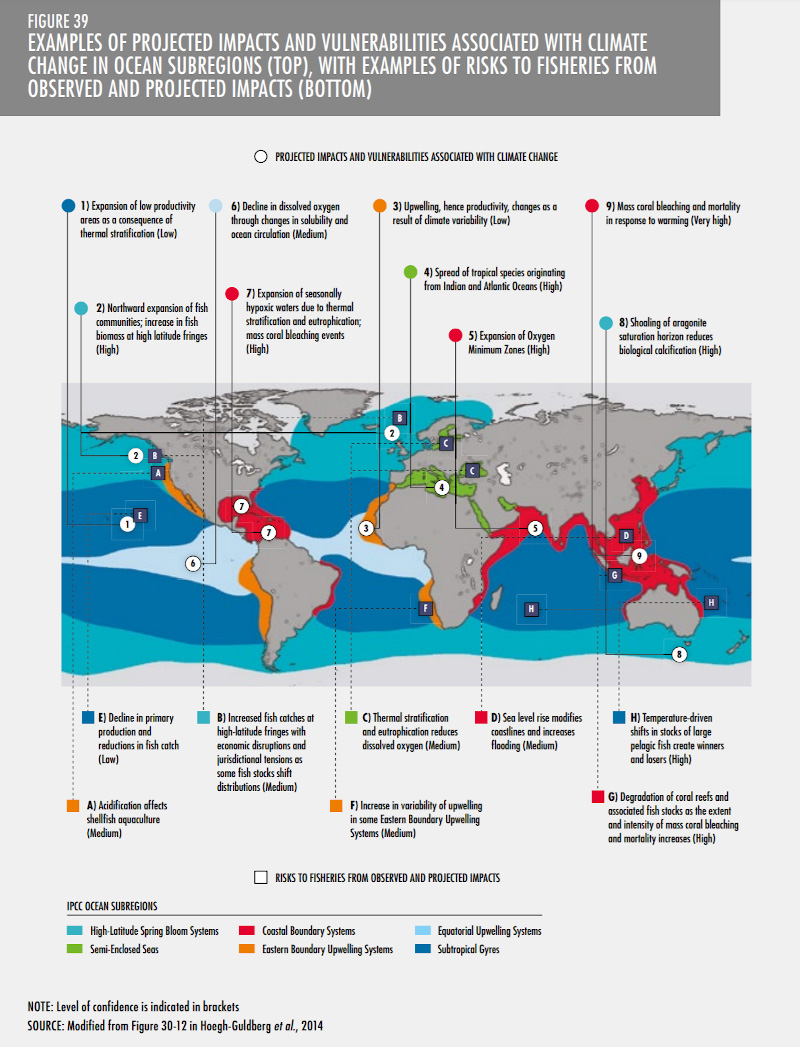Bycatch

White, M. and AgInnovators (2019). Fish see the light: new ‘precision’ nets could end costly bycatch. [online] Aginnovators.org.au.
Bycatch: through commercial fishing of targeted fish, non-targeted species are incidentally captured. Including vaquita, turtles, sharks, and many more.
Depending on how we catch fish, there will be trade-offs between bycatch, investment, efficiency, and environmental damage.
Two Main Options of Fisheries:
- Option #1: Catch a lot of fish at once. Leads to:
- Less time consuming; fish less often
- Higher bycatch
- More expensive
- Option #2: Catch a few fish at a time. Leads to:
- More time consuming; fish more often
- Lower bycatch
- Less expensive

FAO. 2018. The State of World Fisheries and Aquaculture 2018 – Meeting the sustainable development goals. Rome. License: CC BY-NC-SA 3.0 IGO.
Figure 39: It is predicted that by 2050 the projected impacts will occur. Numbers are associated to projected impacts and vulnerabilities associated with climate change, and letters are associated to the risks to fisheries from observed and projected impacts. The colors represent which IPCC ocean subregion is being impacted. The parenthesis after each description is the level of confidence of these occurrences. Tropical regions dependent on fisheries have a predominantly negative impact, whereas the temperate regions will have opportunities arise. Expansion of marine species is distributing poleward to remain in waters with their thermal or ecological preferences. Tropical waters are managing an increased uptake of carbon dioxide, impacting the acidity which is of major concern for calcifying organisms and coral ecosystems. Further research is needed to understand what strategies would allow fisheries and marine species to adapt to global climate change and the distributional shifts that respond.
Solutions to Improving our Way of Living
Responsible Management
- Encourage stewardship
- Transparent policy decisions
- Frequent & accurate fish stock assessment
- Elimination of harmful subsidies
Create & Enforce Marine Protected Areas (MPAs)
- The National Oceanic and Atmospheric Administration’s (NOAA) MPA Inventory
- Monumental marine expansion in Papahanaumokuakea Marine National Monument of the Northwestern Hawaiian Islands (NWHI)
Raise Consumer Awareness with consumer guides
Integrated Multi-Trophic Aquaculture (IMTA)
- IMTA in Canada
- A shared environment between a combination of organisms throughout levels of the food chain. Waste, nutrients and byproducts of one species converts into fertilizer, food and energy for another species.
- Cultivated species (salmon) combined with extractive species (filter feeders, deposit feeders, and dissolved nutrient absorbers) are using organic/inorganic materials & byproducts from other species for their own growth, (mussels, sea cucumbers, worms and various seaweeds).
- Mimics the function of natural ecosystems by recycling nutrients and providing healthier waters through the combining of multiple species at different food chain levels.
- Very expensive to manage but species are chosen based on market value to provide additional benefits for farmers.